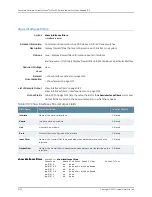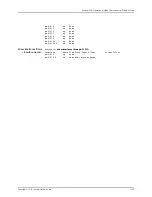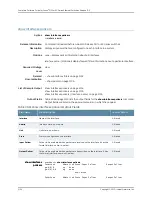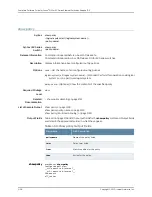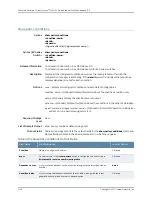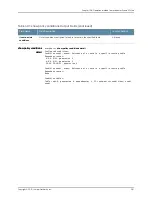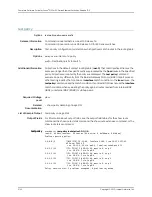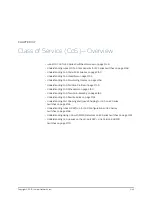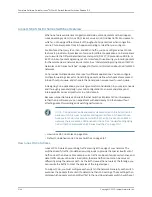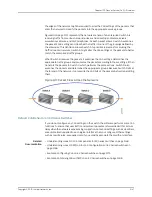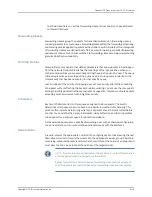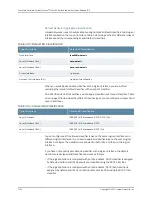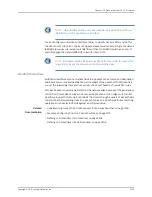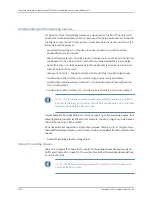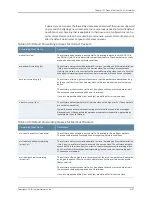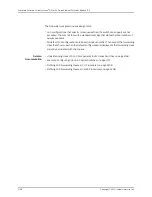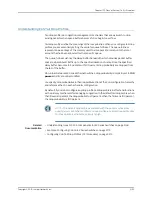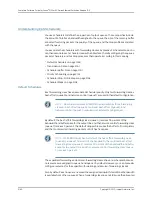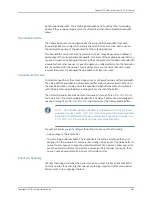
Junos OS CoS for EX Series Switches Overview
When a network experiences congestion and delay, some packets must be dropped.
Junos operating system (Junos OS) class of service (CoS) divides traffic into classes to
which you can apply different levels of throughput and packet loss when congestion
occurs. This allows packet loss to happen according to rules that you configure.
For interfaces that carry IPv4, IPv6, and MPLS traffic, you can configure Junos OS CoS
features to provide multiple classes of service for different applications. CoS also allows
you to rewrite the Differentiated Services code point (DSCP), IP precedence, 802.1p, or
EXP CoS bits of packets egressing out of an interface, thus allowing you to tailor packets
for the remote peers’ network requirements. See “Understanding Using CoS with MPLS
Networks on EX Series Switches” on page 3167 for more information about CoS for MPLS
networks.
CoS provides multiple classes of service for different applications. You can configure
multiple forwarding classes for transmitting packets, define which packets are placed
into each output queue, and schedule the transmission service level for each queue.
In designing CoS applications, you must give careful consideration to your service needs
and thoroughly plan and design your CoS configuration to ensure consistency and
interoperability across all platforms in a CoS domain.
Because Juniper Networks EX Series Ethernet Switches implement CoS in hardware
rather than in software, you can experiment with and deploy CoS features without
affecting packet-forwarding and switching performance.
NOTE:
CoS policies can be enabled or disabled on each interface of an EX
Series switch. Also, each physical and logical interface on the switch can
have custom CoS rules associated with it. When CoS is used in an MPLS
network, there are some additional restrictions. See “Understanding Using
CoS with MPLS Networks on EX Series Switches” on page 3167.
•
How Junos OS CoS Works on page 3146
•
Default CoS Behavior on EX Series Switches on page 3147
How Junos OS CoS Works
Junos OS CoS works by examining traffic entering at the edge of your network. The
switches classify traffic into defined service groups to provide the special treatment of
traffic across the network. For example, voice traffic can be sent across certain links, and
data traffic can use other links. In addition, the data traffic streams can be serviced
differently along the network path. As the traffic leaves the network at the far edge, you
can rewrite the traffic to meet the policies of the targeted peer.
To support CoS, you must configure each switch in the network. Generally, each switch
examines the packets that enter it to determine their CoS settings. These settings then
dictate which packets are transmitted first to the next downstream switch. Switches at
Copyright © 2010, Juniper Networks, Inc.
3146
Complete Software Guide for Junos
®
OS for EX Series Ethernet Switches, Release 10.3
Summary of Contents for JUNOS OS 10.3 - SOFTWARE
Page 325: ...CHAPTER 17 Operational Mode Commands for System Setup 229 Copyright 2010 Juniper Networks Inc ...
Page 1323: ...CHAPTER 56 Operational Mode Commands for Interfaces 1227 Copyright 2010 Juniper Networks Inc ...
Page 2841: ...CHAPTER 86 Operational Commands for 802 1X 2745 Copyright 2010 Juniper Networks Inc ...
Page 3367: ...CHAPTER 113 Operational Mode Commands for CoS 3271 Copyright 2010 Juniper Networks Inc ...
Page 3435: ...CHAPTER 120 Operational Mode Commands for PoE 3339 Copyright 2010 Juniper Networks Inc ...
Page 3529: ...CHAPTER 126 Operational Mode Commands for MPLS 3433 Copyright 2010 Juniper Networks Inc ...

